Soil Salinity Estimation in Cotton Fields in Arid Regions Based on Multi-Granularity Spectral Segmentation (MGSS)
Abstract
1. Introduction
2. Materials and Methods
2.1. Study Site
2.2. Data Collection
2.2.1. Soil Sampling
2.2.2. Determination of Soil Salinity
2.2.3. Spectral Acquisition
2.2.4. Spectral Data Preprocessing
2.3. Selection of Spectral Features
2.4. Model Validation
3. Results
3.1. Spectral Features of Soil EC
3.2. Comparison of Spectral Features
3.3. Model Accuracy Evaluation
3.4. Model Validation
4. Discussion
4.1. Analysis of Spectral Features Extracted Based on Different Spectral Preprocessing Methods
4.2. Comparison of the Estimation Accuracy of the Models Constructed Using Different Spectral Preprocessing Methods
5. Conclusions
Author Contributions
Funding
Data Availability Statement
Conflicts of Interest
References
- Wang, Z.; Zhang, F.; Zhang, X.; Chan, N.W.; Kung, H.; Ariken, M.; Zhou, X.; Wang, Y. Regional suitability prediction of soil salinization based on remote-sensing derivatives and optimal spectral index. Sci. Total Environ. 2021, 775, 145807. [Google Scholar] [CrossRef] [PubMed]
- Sertel, E.; Gorji, T.; Tanik, A. Monitoring soil salinity via remote sensing technology under data scarce conditions: A case study from turkey. Ecol. Indic. 2017, 74, 384–391. [Google Scholar] [CrossRef]
- Chen, H.; Zhao, G.; Li, Y.; Wang, D.; Ma, Y. Monitoring the seasonal dynamics of soil salinization in the Yellow River delta of China using Landsat data. Nat. Hazards Earth Syst. Sci. 2019, 19, 1499–1508. [Google Scholar] [CrossRef]
- O’Neill, B.C.; Oppenheimer, M.; Warren, R.; Hallegatte, S.; Kopp, R.E.; Pörtner, H.O.; Scholes, R.; Birkmann, J.; Foden, W.; Licker, R.; et al. IPCC reasons for concern regarding climate changerisks. Nat. Clim. Chang. 2017, 7, 28–37. [Google Scholar] [CrossRef]
- Zhang, J.Z.; Zou, R.; Wang, Z.H.; Zong, R.; Tan, M.D. Estimation of soil salt content in drip irrigation cotton field using GPR multi-frequency antenna amplitude envelope average method. J. Agric. Eng. 2021, 37, 99–107. [Google Scholar]
- Llyas, N.R.M.M.T.; Shi, Q.G.; Abdulla, A.; Xia, N.; Wang, J.Z. Quantitative evaluation of soil salinization risk in Keriya Oasis based on grey evaluation model. J. Agric. Eng. 2019, 35, 176–184. [Google Scholar] [CrossRef]
- Wang, J.; Ding, J.; Yu, D.; Teng, D.; He, B.; Chen, X.; Su, F. Machine learning-based detection of soil salinity in an arid desert region, Northwest China: A comparison between Landsat-8 OLI and Sentinel-2 MSI. Sci. Total Environ. 2020, 707, 136092. [Google Scholar] [CrossRef] [PubMed]
- Wang, J.Z.; Ding, J.L.; Yu, D.L.; Ma, X.K.; Zhang, Z.P.; Ge, X.Y.; Teng, D.X.; Li, X.H.; Liang, J.; Lizaga, I.; et al. Capability of Sentinel-2 MSI data for monitoring and mapping of soil salinity in dry and wet seasons in the Ebinur Lake region, Xinjiang, China. Geoderma 2019, 353, 172–187. [Google Scholar] [CrossRef]
- Sishodia, R.P.; Ray, R.L.; Singh, S.K. Applications of remote sensing in precision agriculture: A review. Remote Sens. 2020, 12, 3136. [Google Scholar] [CrossRef]
- Fu, C.; Gan, S.; Yuan, X.; Xiong, H.; Tian, A. Determination of soil salt content using a probability neural network model based on particle swarm optimization in areas affected and non-affected by human activities. Remote Sens. 2018, 10, 1387. [Google Scholar] [CrossRef]
- Shi, X.; Song, J.; Wang, H.; Lv, X. Monitoring soil salinization in Manas River Basin, Northwestern China based on multi-spectral index group. Eur. J. Remote Sens. 2021, 54 (Suppl. 2), 176–188. [Google Scholar] [CrossRef]
- Wang, J.; Li, X. Comparison on quantitative inversion of characteristic ions in salinized soils with hyperspectral based on support vector regression and partial least squares regression. Eur. J. Remote Sens. 2020, 53, 340–348. [Google Scholar] [CrossRef]
- Zhang, X.L.; Zhang, F.; Zhang, H.W.; Li, Z.; Hai, Q.; Chen, L.H. Optimization of soil salt inversion model based on spectral preprocessing from hyperspectral index. Trans. Chin. Soc. Agr. Eng. 2018, 34, 110–117. [Google Scholar]
- Li, H.; Zhou, B.; Xu, F. Variation Analysis of Spectral Characteristics of Reclamation Vegetation in a Rare Earth Mining Area Under Environmental Stress. IEEE. Trans. Geosci. Remote Sens. 2022, 60, 4408412. [Google Scholar] [CrossRef]
- Wang, J.Z.; Zhen, J.N.; Hu, W.F.; Chen, S.C.; Lizaga, I.; Zeraatpisheh, M.; Yang, X.D. Remote sensing of soil degradation: Progress and perspective. Int. Soil Water Conserv. 2023, 11, 429–454. [Google Scholar] [CrossRef]
- Biney, J.K.M.; Blöcher, J.R.; Borůvka, L.; Vašát, R. Does the limited use of orthogonal signal correction pre-treatment approach to improve the prediction accuracy of soil organic carbon need attention? Geoderma 2021, 388, 114945. [Google Scholar] [CrossRef]
- Zulfiqar, M.; Ahmad, M.; Sohaib, A.; Mazzara, M.; Distefano, S. Hyperspectral imaging for bloodstain identification. Sensors 2021, 21, 3045. [Google Scholar] [CrossRef] [PubMed]
- Sun, Y.; Cai, W.; Shao, X. Chemometrics: An Excavator in Temperature-Dependent Near-Infrared Spectroscopy. Molecules 2022, 27, 452. [Google Scholar] [CrossRef]
- Wang, J.Z.; Shi, T.Z.; Yu, D.L.; Teng, D.X.; Ge, X.Y.; Zhang, Z.P.; Yang, X.D.; Wang, H.X.; Wu, G.F. Ensemble machine-learning-based framework for estimating total nitrogen concentration in water using drone-borne hyperspectral imagery of emergent plants: A case study in an arid oasis, NW China. Environ. Pollut. 2020, 266, 115412. [Google Scholar] [CrossRef]
- Kang, X.Y.; Zhang, W. Hyperspectral remote sensing estimation of pasture crude protein content based on multi-granularity spectral feature. J. Agric. Eng. 2019, 35, 161–169. [Google Scholar] [CrossRef]
- Kang, X.Y.; Huang, C.P.; Zhang, L.F.; Zhang, Z.; Lv, X. Downscaling solar-induced chlorophyll fluorescence for field-scale cotton yield estimation by a two-step convolutional neural network. Comput. Electron. Agric. 2022, 201, 107260. [Google Scholar] [CrossRef]
- Li, N. The Influence of American Sanctions on Cotton Growers in XPCC; Tarim University: Aral, China, 2022. [Google Scholar]
- Tomaz, A.; Palma, P.; Alvarenga, P.; Gonçalves, M.C. Soil salinity risk in a climate change scenario and its effect on crop yield. Clim. Chang. Soil Interact. 2020, 351–396. [Google Scholar] [CrossRef]
- Sidiropoulos, P.; Dalezios, N.R.; Loukas, A.; Mylopoulos, N.; Spiliotopoulos, M.; Faraslis, I.N.; Alpanakis, N.; Sakellariou, S. Quantitative classification of desertification severity for degraded aquifer based on remotely sensed drought assessment. Hydrology 2021, 8, 47. [Google Scholar] [CrossRef]
- Helat, F.; Moncef, B.; Mourad, B.; Samir, B. Detection of terrain indices related to soil salinity and mapping sal-affected soils using remote sensing and geostatitical techniques. Environ. Monit. Assess. 2017, 189, 177–187. [Google Scholar] [CrossRef]
- Zhang, J.H.; Jia, P.P.; Sun, Y.; Jia, K.L. Prediction of salinity ion content in different soil layers based on hyperspectral data. J. Agric. Eng. 2019, 35, 106–115. [Google Scholar] [CrossRef]
- Xu, X.; Chen, Y.; Wang, M.; Wang, S.; Li, K.; Li, Y. Improving estimates of soil salt content by using two-date image spectral changes in Yinbei, China. Remote Sens. 2021, 13, 4165. [Google Scholar] [CrossRef]
- Wang, X.P.; Jiang, F.C.; Wang, H.B.; Cao, H.; Yang, Y.P.; Gao, Y. Irrigation scheduling optimization of drip-irrigated without plastic film cotton in south Xinjiang based on Aqua Crop model. J. Agric. Mach. 2021, 52, 293–301. [Google Scholar]
- Liu, J. The Applications of Remote Sensing Models of Soil Salinization Based on Feature Space; Xinjiang Agricultural University: Urumqi, China, 2022. [Google Scholar]
- Luo, M.; Liu, T.; Meng, F.H.; Duan, Y.C.; Bao, B.M.; Xing, W.; Feng, X.W. Identifying climate change impacts on water resources in Xinjiang, China. Sci. Total Environ. 2019, 676, 613–626. [Google Scholar] [CrossRef]
- Hu, J.; Peng, J.; Zhou, Y.; Xu, D.Y.; Zhao, R.Y.; Jiang, Q.S.; Fu, T.T.; Wang, F.; Shi, Z. Quantitative Estimation of SoilSalinity Using UAV-Borne Hyperspectral and Satellite Multispectral Images. Remote Sens. 2019, 11, 736. [Google Scholar] [CrossRef]
- Benslama, A.; Khanchoul, K.; Benbrahim, F.; Boubehziz, S.; Chikhi, F.; Navarro-Pedreño, J. Monitoring the Variations of Soil Salinity in a Palm Grove in Southern Algeria. Sustainability 2020, 12, 6117. [Google Scholar] [CrossRef]
- Kong, C.; Camps-Arbestain, M.; Clothier, B.; Bishop, P.; Vázquez, F.M. Reclamation of salt-affected soils using pumice and algal amendments: Impact on soil salinity and the growth of lucerne. Environ. Technol. Innov. 2021, 24, 101867. [Google Scholar] [CrossRef]
- Ren, J.H.; Chen, Q.; Ma, D.L.; Xie, R.F.; Zhu, H.L.; Zang, S.Y. Study on a fast EC measurement method of soda saline-alkali soil based on wavelet decomposition texture feature. Catena 2021, 203, 105272. [Google Scholar] [CrossRef]
- Kang, X.Y.; Zhang, W. A novel method for high-order residual quantization-based spectral binary coding. Spectrosc. Spect. Anal. 2019, 39, 3013–3020. [Google Scholar]
- Mendoza, F.A.; Wiesinger, J.A.; Lu, R.; Nchimbi-Msolla, S.; Miklas, P.N.; Kelly, J.D.; Cichy, K.A. Prediction of cooking time for soaked and unsoaked dry beans (Phaseolus vulgaris L.) using hyperspectral imaging technology. Plant. Phenome J. 2018, 1, 1–9. [Google Scholar] [CrossRef]
- Pan, B.; Yu, H.; Cheng, H.; Du, S.; Feng, S.; Shu, Y.; Du, J.; Xie, H. Machine Learning Model of Hydrothermal Vein Copper Deposits at Meso-Low Temperatures Based on Visible-Near Infrared Parallel Polarized Reflectance Spectroscopy. Minerals 2022, 12, 1451. [Google Scholar] [CrossRef]
- Chen, W.H.; Chen, H.Z.; Feng, Q.X.; Mo, L.N.; Hong, S.Y. A hybrid optimization method for sample partitioning in near-infrared analysis. Spectrochim. Acta A 2021, 248, 119182. [Google Scholar] [CrossRef]
- Zhao, Y.; Zhao, Z.; Shan, P.; Peng, L.S.; Yu, J.L.; Gao, D.L. Calibration transfer based on affine invariance for NIR without transfer standards. Molecules 2019, 24, 1802. [Google Scholar] [CrossRef]
- Solangi, K.A.; Siyal, A.A.; Wu, Y.; Abbasi, B.; Solangi, F.; Lakhiar, I.A.; Zhou, G. An Assessment of the Spatial and Temporal Distribution of Soil Salinity in Combination with Field and Satellite Data: A Case Study in Sujawal District. Agronomy 2019, 9, 869. [Google Scholar] [CrossRef]
- Ivushkin, K.; Bartholomeus, H.; Bregt, A.K.; Pulatov, A.; Franceschini, M.H.D.; Kramer, H.; van Loo, E.N.; Jaramillo Roman, V.; Finkers, R. UAV based soil salinity assessment of cropland. Geoderma 2019, 338, 502–512. [Google Scholar] [CrossRef]
- Zhang, S.; Zhao, G. A Harmonious Satellite-Unmanned Aerial Vehicle-Ground Measurement Inversion Method for Monitoring Salinity in Coastal Saline Soil. Remote Sens. 2019, 11, 1700. [Google Scholar] [CrossRef]
- Qi, G.; Chang, C.; Yang, W.; Gao, P.; Zhao, G. Soil Salinity Inversion in Coastal Corn Planting Areas by the Satellite-UAV-Ground Integration Approach. Remote Sens. 2021, 13, 3100. [Google Scholar] [CrossRef]
- Liu, Y.; Zhang, F.; Wang, C.; Wu, S.; Liu, J.; Xu, A.; Pan, K.; Pan, X. Estimating the soil salinity over partially vegetated surfaces from multispectral remote sensing image using non-negative matrix factorization. Geoderma 2019, 354, 113887. [Google Scholar] [CrossRef]
- Sankey, J.B.; Sankey, T.T.; Li, J.; Ravi, S.; Wang, G.; Caster, J.; Kasprak, A. Quantifying plant-soil-nutrient dynamics in rangelands: Fusion of UAV hyperspectral-LiDAR, UAV multispectral-photogrammetry, and ground-based LiDAR-digital photography in a shrub-encroached desert grassland. Remote Sens. Environ. 2021, 253, 112223. [Google Scholar] [CrossRef]
- Wang, J.Z.; Hu, X.J.; Shi, T.Z.; He, L.; Hu, W.F.; Wu, G.F. Assessing toxic metal chromium in the soil in coal mining areas via proximal sensing: Prerequisites for land rehabilitation and sustainable development. Geoderma 2022, 405, 115399. [Google Scholar] [CrossRef]
- Khosravi, V.; Doulati Ardejani, F.; Yousefi, S.; Aryafar, A. Monitoring soil lead and zinc contents via combination of spectroscopy with extreme learning machine and other data mining methods. Geoderma 2018, 318, 29–41. [Google Scholar] [CrossRef]
- Zhou, W.; Yang, H.; Xie, L.; Li, H.; Huang, L.; Zhao, Y.; Yue, T. Hyperspectral inversion of soil heavy metals in Three-River Source Region based on random forest model. Catena 2021, 202, 105222. [Google Scholar] [CrossRef]
- Wu, D.; Jia, K.; Zhang, X.; Zhang, J.; Abd El-Hamid, H.T. Remote Sensing Inversion for Simulation of Soil Salinization Based on Hyperspectral Data and Ground Analysis in Yinchuan, China. Nat. Resour. Res. 2021, 30, 4641–4656. [Google Scholar] [CrossRef]
- Mandal, A.K. The need for the spectral characterization of dominant salts and recommended methods of soil sampling and analysis for the proper spectral evaluation of salt affected soils using hyper-spectral remote sensing. Remote Sens. Lett. 2022, 13, 588–598. [Google Scholar] [CrossRef]
- Wang, X.; Song, K.; Wang, Z.; Li, S.; Zheng, M.; Wen, Z.; Liu, G. Are topsoil spectra or soil-environmental factors better indicators for discrimination of soil classes? Catena 2022, 218, 106580. [Google Scholar] [CrossRef]
- Guo, B.; Zang, W.; Luo, W.; Wen, Y.; Yang, F.; Han, B.; Yang, X. Detection model of soil salinization information in the Yellow River Delta based on feature space models with typical surface parameters derived from Landsat8 OLI image. Geomat. Nat. Hazards Risk 2020, 11, 288–300. [Google Scholar] [CrossRef]
- Zhu, K.; Sun, Z.; Zhao, F.; Yang, T.; Tian, Z.; Lai, J.; Long, B. Relating hyperspectral vegetation indices with soil salinity at different depths for the diagnosis of winter wheat salt stress. Remote Sens. 2021, 13, 250. [Google Scholar] [CrossRef]
- Farahmand, N.; Sadeghi, V. Estimating Soil Salinity in the dried lake bed of urmia lake using pptical sentinel-2 images and nonlinear regression models. J. Indian Soc. Remote 2020, 48, 675–687. [Google Scholar] [CrossRef]
- Zhou, X.X.; Li, Y.Y.; Luo, Y.K.; Sun, Y.W.; Su, Y.J.; Tan, C.W.; Liu, Y.J. Research on remote sensing classification of fruit trees based on Sentinel-2 multi-temporal imageries. Sci. Rep. 2022, 12, 11549. [Google Scholar] [CrossRef] [PubMed]
- Duan, P.C.; Xiong, H.G.; Li, R.R.; Zhang, L. A quantitative analysis of the reflectance of the saline soil under different disturbance extent. Spectrosc. Spect. Anal. 2017, 37, 571–576. [Google Scholar]
- Yasenjiang, K.; Yang, S.T.; Negra, T.S.F.T.; Zhang, F. Hyperspectral estimation of soil electrical conductivity based on fractional order differentially optimised spectral indices. J. Ecol. 2019, 39, 7237–7248. [Google Scholar] [CrossRef]
- Pang, H.Y.; Zhang, A.W.; Kang, X.Y.; He, N.P.; Dong, G. Estimation of the grassland aboveground biomass of the inner mongolia plateau using the simulated spectra of sentinel-2 Images. Remote Sens. 2020, 12, 4155. [Google Scholar] [CrossRef]
- Özger, M.; Başakın, E.E.; Ekmekcioğlu, Ö.; Hacısüleyman, V. Comparison of wavelet and empirical mode decomposition hybrid models in drought prediction. Comput. Electron. Agric. 2020, 179, 105851. [Google Scholar] [CrossRef]
- Fathizad, H.; Ardakani, M.A.H.; Sodaiezadeh, H.; Kerry, R.; Taghizadeh-Mehrjardi, R. Investigation of the spatial and temporal variation of soil salinity using random forests in the central desert of Iran. Geoderma 2020, 365, 114233. [Google Scholar] [CrossRef]
- Ouerghemmi, W.; Gomez, C.; Naceur, S.; Lagacherie, P. Semi-blind source separation for the estimation of the clay content over semi-vegetated areas using VNIR/SWIR hyperspectral airborne data. Remote Sens. Environ. 2016, 181, 251–263. [Google Scholar] [CrossRef]
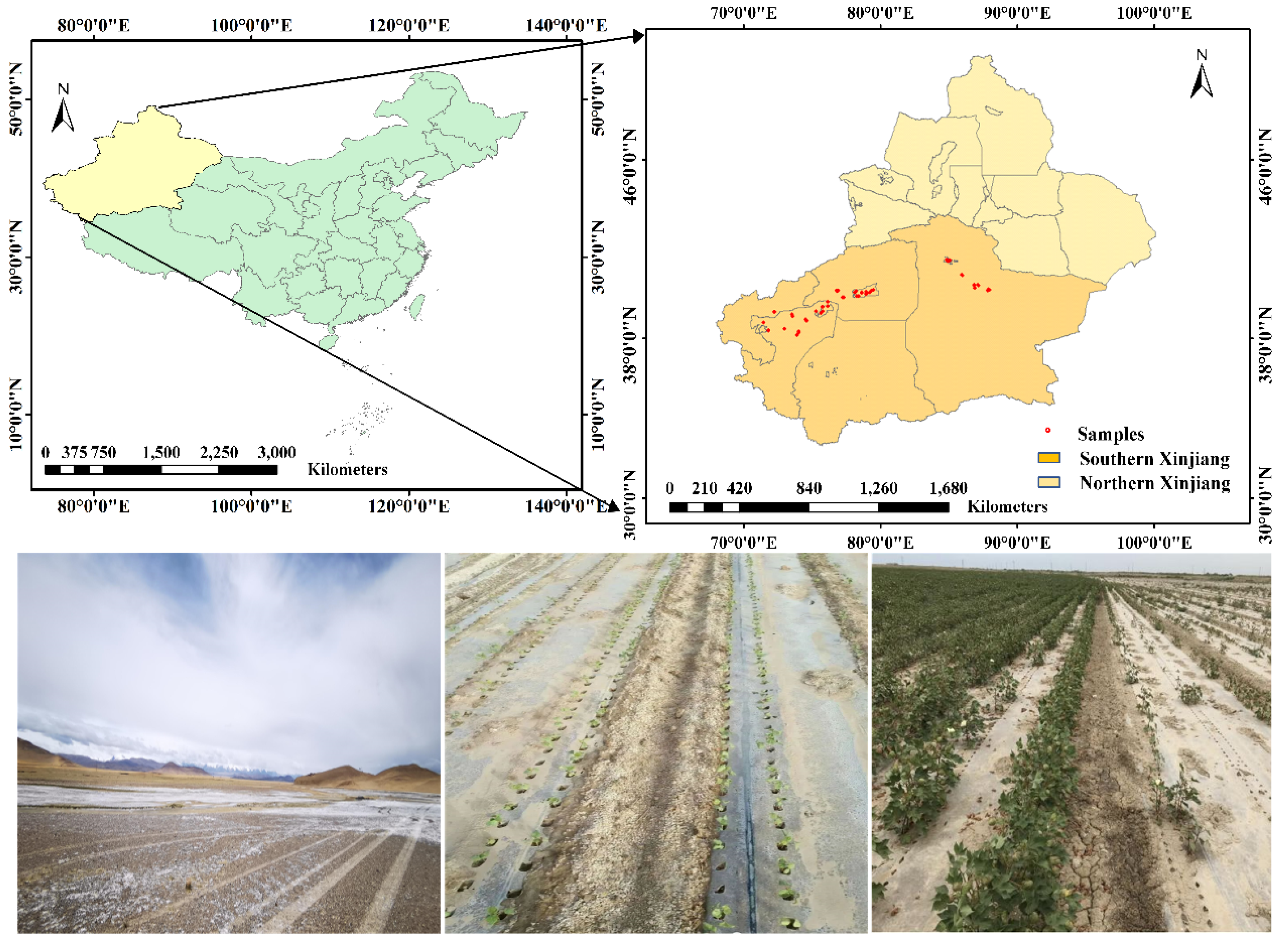
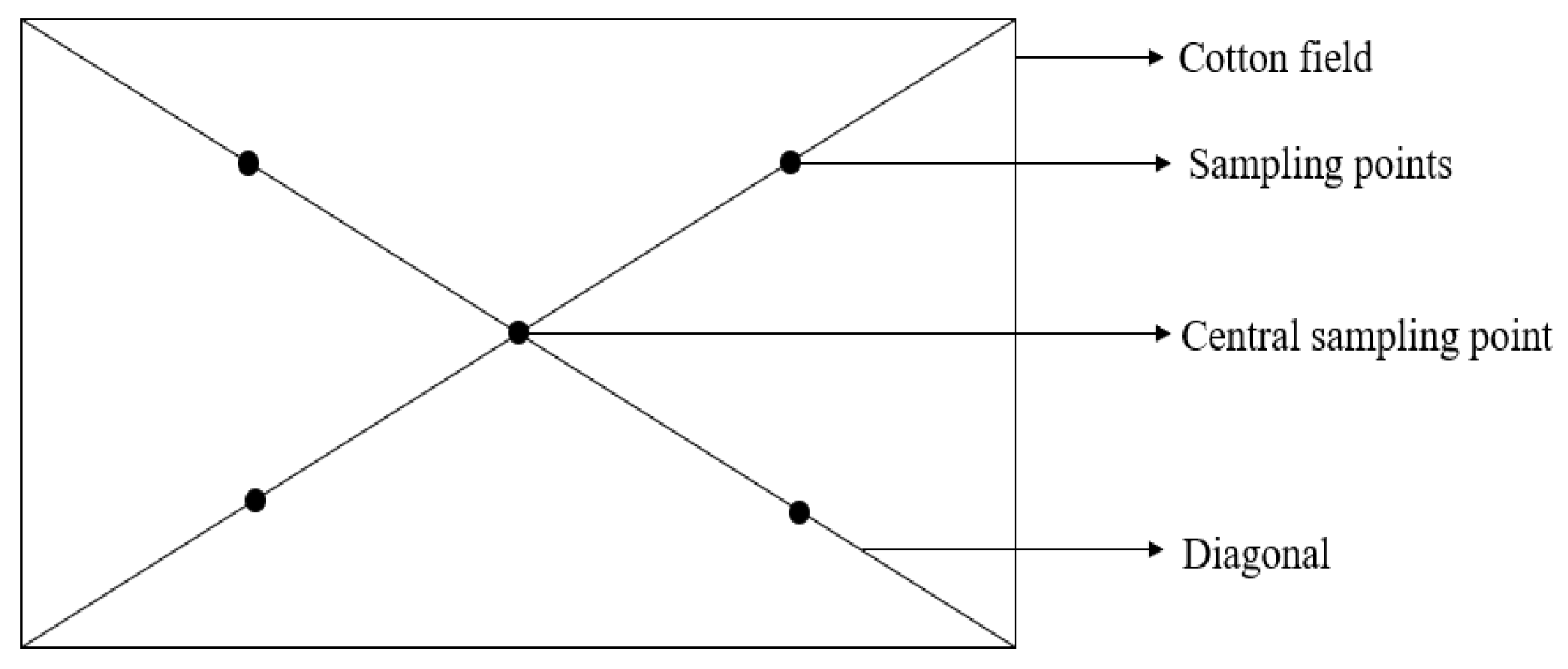


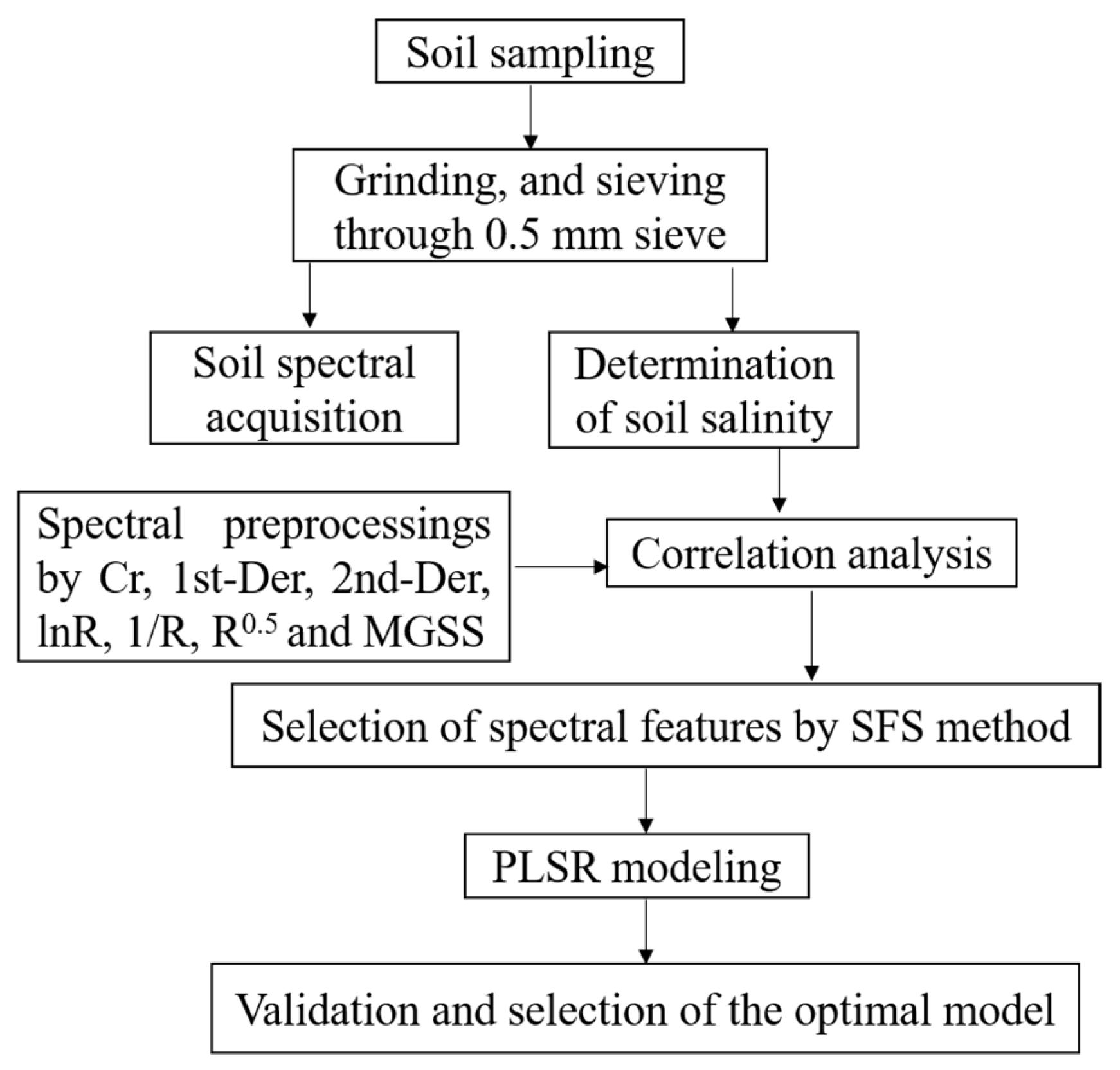
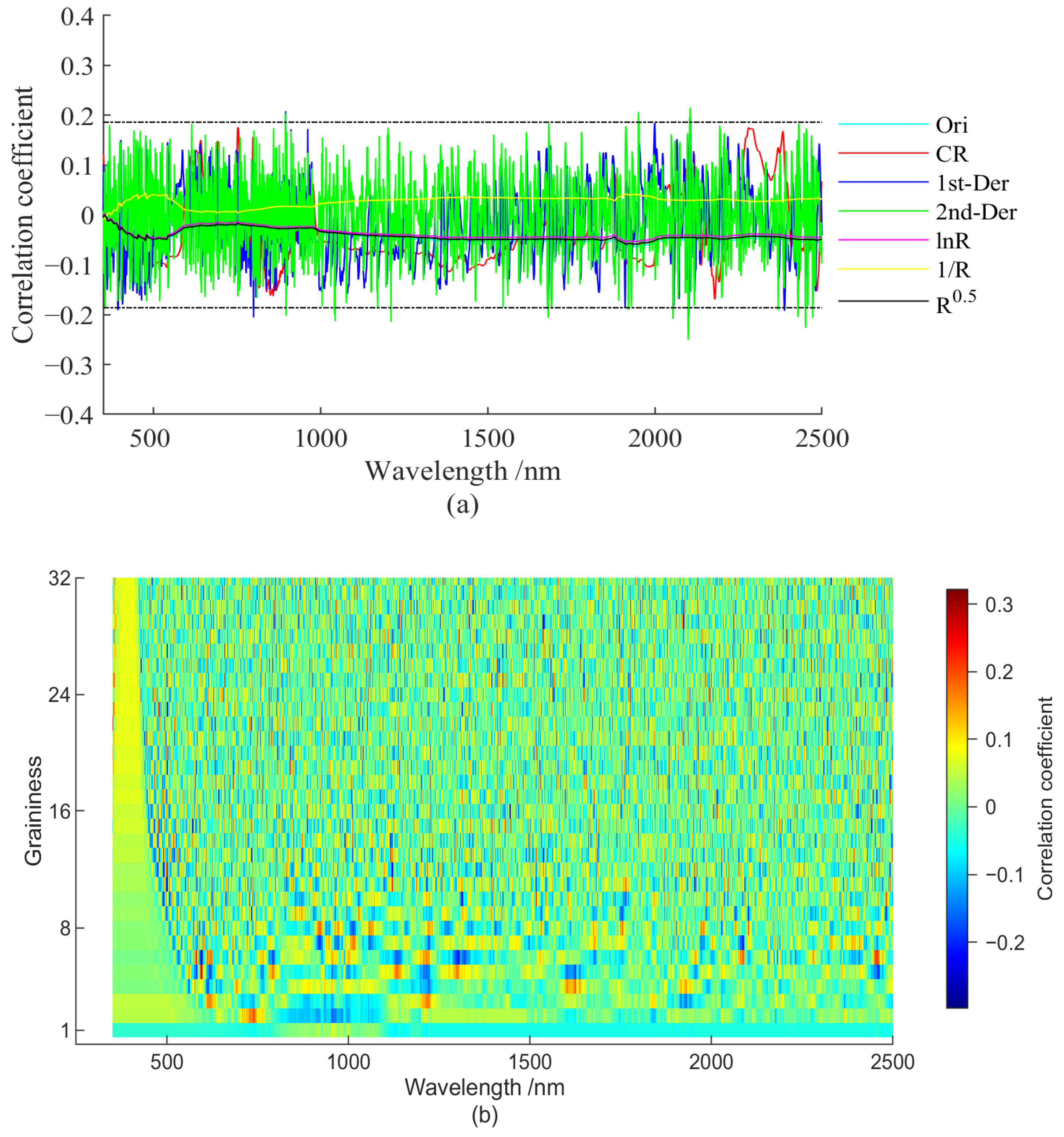

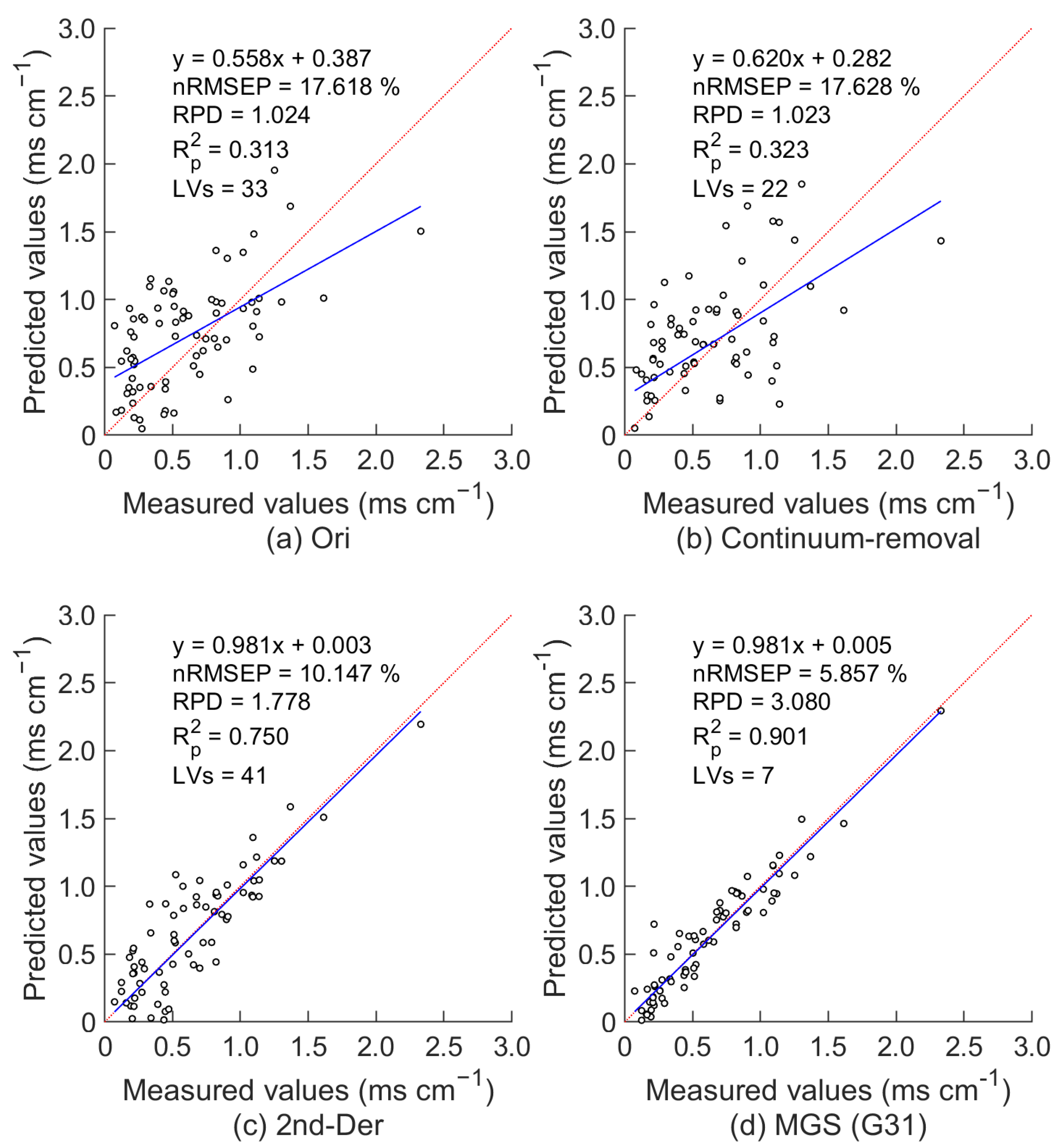
| Dataset | No. | Max. | Min. | Mean | Std | Cv | Kurtosis | Skewness |
|---|---|---|---|---|---|---|---|---|
| Full dataset | 191 | 2.37 | 0.06 | 0.73 | 0.49 | 0.67 | 3.57 | 0.89 |
| Calibration set | 115 | 2.37 | 0.06 | 0.81 | 0.52 | 0.63 | 2.98 | 0.66 |
| Validation set | 76 | 2.33 | 0.07 | 0.60 | 0.42 | 0.70 | 5.49 | 1.28 |
| Method | LVs | Rc2 | nRMSEC (%) | Rp2 | nRMSEP (%) | RPD |
|---|---|---|---|---|---|---|
| Ori | 33 | 0.80 | 9.87 | 0.31 | 17.62 | 1.02 |
| CR | 22 | 0.77 | 10.73 | 0.32 | 17.63 | 1.02 |
| 1st-Der | 28 | 0.94 | 5.61 | 0.65 | 10.94 | 1.65 |
| 2nd-De | 41 | 0.94 | 5.35 | 0.75 | 10.15 | 1.78 |
| 1/R | 30 | 0.77 | 10.73 | 0.33 | 17.49 | 1.03 |
| R0.5 | 3 | 0.09 | 21.16 | 0.06 | 23.27 | 0.78 |
| lnR | 31 | 0.77 | 10.74 | 0.48 | 17.61 | 1.02 |
| MGSS_31 | 7 | 0.95 | 4.89 | 0.90 | 5.86 | 3.08 |
Disclaimer/Publisher’s Note: The statements, opinions and data contained in all publications are solely those of the individual author(s) and contributor(s) and not of MDPI and/or the editor(s). MDPI and/or the editor(s) disclaim responsibility for any injury to people or property resulting from any ideas, methods, instructions or products referred to in the content. |
© 2023 by the authors. Licensee MDPI, Basel, Switzerland. This article is an open access article distributed under the terms and conditions of the Creative Commons Attribution (CC BY) license (https://creativecommons.org/licenses/by/4.0/).
Share and Cite
Fan, X.; Kang, X.; Gao, P.; Zhang, Z.; Wang, J.; Zhang, Q.; Zhang, M.; Ma, L.; Lv, X.; Zhang, L. Soil Salinity Estimation in Cotton Fields in Arid Regions Based on Multi-Granularity Spectral Segmentation (MGSS). Remote Sens. 2023, 15, 3358. https://doi.org/10.3390/rs15133358
Fan X, Kang X, Gao P, Zhang Z, Wang J, Zhang Q, Zhang M, Ma L, Lv X, Zhang L. Soil Salinity Estimation in Cotton Fields in Arid Regions Based on Multi-Granularity Spectral Segmentation (MGSS). Remote Sensing. 2023; 15(13):3358. https://doi.org/10.3390/rs15133358
Chicago/Turabian StyleFan, Xianglong, Xiaoyan Kang, Pan Gao, Ze Zhang, Jin Wang, Qiang Zhang, Mengli Zhang, Lulu Ma, Xin Lv, and Lifu Zhang. 2023. "Soil Salinity Estimation in Cotton Fields in Arid Regions Based on Multi-Granularity Spectral Segmentation (MGSS)" Remote Sensing 15, no. 13: 3358. https://doi.org/10.3390/rs15133358
APA StyleFan, X., Kang, X., Gao, P., Zhang, Z., Wang, J., Zhang, Q., Zhang, M., Ma, L., Lv, X., & Zhang, L. (2023). Soil Salinity Estimation in Cotton Fields in Arid Regions Based on Multi-Granularity Spectral Segmentation (MGSS). Remote Sensing, 15(13), 3358. https://doi.org/10.3390/rs15133358








